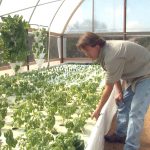Top Tomato Tips
encore date: March 19, 2015
original air date: February 26, 2015
Thinking about homegrown tomatoes? Let’s get growing with “the tomato guy” Bill Adams, author of The Texas Tomato Lover’s Handbook. Get some of his tricks for the tastiest tomatoes in town. On tour, find out what aquaponics is all about with Rob Nash in his Austin Aquaponics greenhouse. Daphne answers: which cold hardy Satsuma should we pick? Native evergreen sumac is our Plant of the Week for its drought defiant hardiness and flowers and fruits for wildlife. Since it’s not too late to start warm weather food and flowers indoors, John Dromgoole demonstrates how to do it.

 Rob Nash
Rob Nash Daphne Richards
Daphne Richards John Dromgoole
John Dromgoole